Cooling Panel with Integrated PCM Layer: A Verified Simulation Study
Abstract
1. Introduction
- Room without PCM panels;
- Room with passive PCM panels;
- Room with active PCM panels.
Goals and Objectives
- To perform a series of experiments with PCM panels in a test chamber;
- To perform a simulation case study using the validated simulation model of the PCM panel and compare it with the results from other similar studies.
2. Materials and Methods
- A base case with no cooling panel and no phase change materials present in the test chamber;
- A case with a PCM cooling panel with integrated hydronic circuit and a cooling water flow.
2.1. Test Chamber
- side walls of the chamber (arranged from inside to outside):
- ○
- wood chip board (12 mm);
- ○
- wooden studs with mineral wool insulation (100 mm);
- ○
- plywood board (12 mm);
- front and back walls of the chamber (arranged from inside to outside):
- ○
- plywood board (12 mm);
- ○
- wooden studs with mineral wool insulation (100 mm);
- ○
- plywood board (12 mm);
- roof of the chamber (arranged from inside to outside):
- ○
- plywood board (12 mm);
- ○
- expanded polystyrene insulation (50 mm)
- ○
- gypsum board (13 mm)
- floor of the chamber (arranged from inside to outside):
- ○
- gypsum board (13 mm);
- ○
- expanded polystyrene insulation (50 mm);
- ○
- plywood board (12 mm);
- glazed door:
- ○
- U value for the glazing 1.1 W/m2K;
- ○
- U value for the frame 3.0 W/m2K (37% of door area).
- Ht—Heat loss coefficient, W/K
- Ph—Power of the heat source, W
- Tc—Temperature inside the chamber, K
- Ts—Temperature of the surrounding environment, K
- T1—Surface temperature sensor on the upper face of the panel;
- T2—Surface temperature sensor on the lower face of the panel;
- TH3—Air temperature and humidity sensor outside the chamber;
- T4—Surface temperature sensor for the supply pipe of the panel;
- T5—Surface temperature sensor for the return pipe of the panel;
- TH6—Air temperature and humidity sensor in the middle part of the chamber;
- TH7—Air temperature and humidity sensor in the lower part of the chamber;
- TH8—Air temperature and humidity sensor in the upper part of the chamber.
2.2. The Cooling Panel
2.3. Simulated Heat Gains
- q—Radiant heat transfer, W
- ε—Emissivity
- δ—Stefan–Boltzmann constant (5.670373×10−8 W/m2 K4)
- Th—Emitting body absolute temperature, K
- Tc—Surroundings absolute temperature, K
- A—Area of the emitting body, m2
2.4. Simulation Model for Validation
- ANSI/ASHRAE Standard 140-2004;
- CEN Standards EN 15255-2007 and EN 15265-2007;
- CEN Standard EN 13791;
- International Energy Agency SHC Task 34;
- Technical Memorandum 33 (TM 33).
2.5. Simulation Model for Performance Modelling
3. Results and Discussion
3.1. Verification of the Simulation Model
3.1.1. Simulation Model without a PCM Cooling Panel
3.1.2. Simulation Model with a PCM Cooling Panel and Cooling Water Connection
3.2. Performance Modelling—Comparative Case
4. Conclusions
Author Contributions
Funding
Acknowledgments
Conflicts of Interest
Appendix A
References
- Sergeev, V.V.; Petrichenko, M.R.; Nemova, D.V.; Kotov, E.V.; Tarasova, D.S.; Nefedova, A.V.; Borodinecs, A.B. The building extension with energy efficiency light-weight building walls. Mag. Civ. Eng. 2018, 84, 67–74. [Google Scholar] [CrossRef]
- The BRE Centre for Resilience. Overheating in dwellings Guidance Document. 2016. Available online: https://www.bre.co.uk/filelibrary/Briefing%20papers/116885-Overheating-Guidance-v3.pdf (accessed on 24 October 2020).
- Aebischer, B.; Henderson, G.; Jakob, M.; Catenazzi, G. Impact of climate change on thermal comfort, heating and cooling energy demand in Europe. In Proceedings of the ECEEE 2007 Summer Study, La Colle sur Loup, France, 4–9 June 2007; pp. 859–870. [Google Scholar]
- Maivel, M.; Kurnitski, J.; Kalamees, T. Field survey of overheating problems in Estonian apartment buildings. Archit. Sci. Rev. 2015, 58, 1–10. [Google Scholar] [CrossRef]
- Gorshkov, A.S.; Vatin, N.I.; Rymkevich, P.P. Climate change and the thermal island effect in the million-plus city. Constr. Unique Build. Struct. 2020, 89, 8902. [Google Scholar] [CrossRef]
- De Luca, F.; Dogan, T.; Kurnitski, J. Methodology for determining fenestration ranges for daylight and energy efficiency in Estonia. In Proceedings of the Simulation Series, Delft, The Netherlands, 5–7 June 2018; Volume 50, pp. 47–54. [Google Scholar]
- Borodinecs, A.; Zemitis, J.; Geikins, A.; Bykova, I.; Nefedova, A.; Kupavykh, S. Energy-efficient construction in the climatic conditions of Latvia. Constr. Unique Build. Struct. 2018, 66, 41–48. [Google Scholar] [CrossRef]
- International Energy Agency. The Future of Cooling. Available online: https://www.oecd-ilibrary.org/energy/the-future-of-cooling_9789264301993-en (accessed on 24 October 2020).
- Saffari, M.; De Gracia, A.; Ushak, S.; Cabeza, L.F. Economic impact of integrating PCM as passive system in buildings using Fanger comfort model. Energy Build. 2016, 112, 159–172. [Google Scholar] [CrossRef]
- Zeinelabdein, R.; Omer, S.; Gan, G. Critical review of latent heat storage systems for free cooling in buildings. Renew. Sustain. Energy Rev. 2018, 82, 2843–2868. [Google Scholar] [CrossRef]
- Voelker, C.; Kornadt, O.; Ostry, M. Temperature reduction due to the application of phase change materials. Energy Build. 2008, 40, 937–944. [Google Scholar] [CrossRef]
- Arce, P.; Castellón, C.; Castell, A.; Cabeza, L.F. Use of microencapsulated PCM in buildings and the effect of adding awnings. Energy Build. 2012, 44, 88–93. [Google Scholar] [CrossRef]
- Evola, G.; Marletta, L.; Sicurella, F. A methodology for investigating the effectiveness of PCM wallboards for summer thermal comfort in buildings. Build. Environ. 2013, 59, 517–527. [Google Scholar] [CrossRef]
- Barzin, R.; Chen, J.J.J.; Young, B.R.; Farid, M.M. Application of PCM energy storage in combination with night ventilation for space cooling. Appl. Energy 2015, 158, 412–421. [Google Scholar] [CrossRef]
- Vanaga, R.; Blumberga, A.; Freimanis, R.; Mols, T.; Blumberga, D. Solar facade module for nearly zero energy building. Energy 2018, 157, 1025–1034. [Google Scholar] [CrossRef]
- Osterman, E.; Hagel, K.; Rathgeber, C.; Butala, V.; Stritih, U. Parametrical analysis of latent heat and cold storage for heating and cooling of rooms. Appl. Therm. Eng. 2015, 84, 138–149. [Google Scholar] [CrossRef]
- Darzi, A.A.R.; Moosania, S.M.; Tan, F.L.; Farhadi, M. Numerical investigation of free-cooling system using plate type PCM storage. Int. Commun. Heat Mass Transf. 2013, 48, 155–163. [Google Scholar] [CrossRef]
- Borcuch, M.; Musiał, M.; Sztekler, K.; Kalawa, W.; Gumuła, S.; Stefański, S. The influence of flow modification on air and PCM temperatures in an accumulative heat exchanger. In Proceedings of the EPJ Web of Conferences, Mikulov, Czech Republic, 21–24 November 2017; Volume 180. [Google Scholar]
- Borderon, J.; Virgone, J.; Cantin, R. Modeling and simulation of a phase change material system for improving summer comfort in domestic residence. Appl. Energy 2015, 140, 288–296. [Google Scholar] [CrossRef]
- Wang, X.; Niu, J.; van Paassen, A.H.C. Raising evaporative cooling potentials using combined cooled ceiling and MPCM slurry storage. Energy Build. 2008, 40, 1691–1698. [Google Scholar] [CrossRef]
- Koschenz, M.; Lehmann, B. Development of a thermally activated ceiling panel with PCM for application in lightweight and retrofitted buildings. Energy Build. 2004, 36, 567–578. [Google Scholar] [CrossRef]
- Klinker, F.; Weinläder, H.; Konstantinidou, C. Dynamic Thermal Behaviour of Two Newly Developed PCM Cooling Ceiling Prototypes. Int. Sloar Energy Soc. 2015, 1–10. [Google Scholar] [CrossRef]
- Weinläder, H.; Klinker, F.; Yasin, M. PCM cooling ceilings in the Energy Efficiency Center—Passive cooling potential of two different system designs. Energy Build. 2016, 119, 93–100. [Google Scholar] [CrossRef]
- Rucevskis, S.; Akishin, P.; Korjakins, A. Numerical Study of Application of PCM for a Passive Thermal Energy Storage System for Space Cooling in Residential Buildings. In Proceedings of the IOP Conference Series: Materials Science and Engineering, Prague, Czech Republic, 17–21 June 2019; Volume 603. [Google Scholar]
- Rucevskis, S.; Akishin, P.; Korjakins, A. Performance Evaluation of an Active PCM Thermal Energy Storage System for Space Cooling in Residential Buildings. Environ. Clim. Technol. 2019, 23, 74–89. [Google Scholar] [CrossRef]
- ASHRAE ASHRAE Fundamentals. 2017. Available online: http://ashrae-meteo.info/v2.0/ (accessed on 24 October 2020).
- Empirical Validation of Iowa Energy Resource Station Building Energy Analysis Simulation Models. A Report of Task 22, Subtask A Building Energy Analysis Tools Project A.1 Empirical Validation June. 2001. Available online: http://www.task39.iea-shc.org/data/sites/1/publications/Iowa_Energy_Report.pdf (accessed on 24 October 2020).
- Sahlin, P.; Grozman, P. IDA Simulation Environment a tool for Modelica based end-user application deployment. In Proceedings of the 3rd International Modelica Conference, Linköping, Sweden, 3–4 November 2003; pp. 105–114. [Google Scholar]
- Modelica Association. Available online: https://www.modelica.org (accessed on 13 September 2020).
- Sahlin, P. NMF Handbook; KTH: Stockholm, Sweden, 1996. [Google Scholar]
- Sahlin, P.; Sowell, E.F. A neutral model format for building simulation models. IBPSA Build. Simul. Conf. 1989, 89, 147–154. [Google Scholar]
- Rubitherm GmbH Technical Data Sheet for RT22HC. Available online: https://www.rubitherm.eu/media/products/datasheets/Techdata_-RT22HC_EN_06082018.PDF (accessed on 5 May 2019).
- Anderlind, G. A new model for calculating the effects of two and three-dimensional thermal bridges. In Proceedings of the 5th Symposium Building Physics in the Nordic Contries; Chalmers Univerity of Technology: Goteborg, Sweden, 1999. [Google Scholar]
- Nageler, P.; Schweiger, G.; Pichler, M.; Brandl, D.; Mach, T.; Heimrath, R.; Schranzhofer, H.; Hochenauer, C. Validation of dynamic building energy simulation tools based on a real test-box with thermally activated building systems (TABS). Energy Build. 2018, 168, 42–55. [Google Scholar] [CrossRef]
- Cornaro, C.; Pierro, M.; Roncarati, D.; Puggioni, V. Validation of a PCM simulation tool in IDA ICE dynamic building simulation software using experimental data from solar test boxes. In Proceedings of the Building Simulation Applications, Bolzano, Italy, 8–10 February 2017; Volume 2017, pp. 159–166. [Google Scholar]
- Gorshkov, A.S.; Vatin, N.I.; Rymkevich, P.P.; Kydrevich, O.O. Payback period of investments in energy saving. Mag. Civ. Eng. 2018, 78, 65–75. [Google Scholar] [CrossRef]
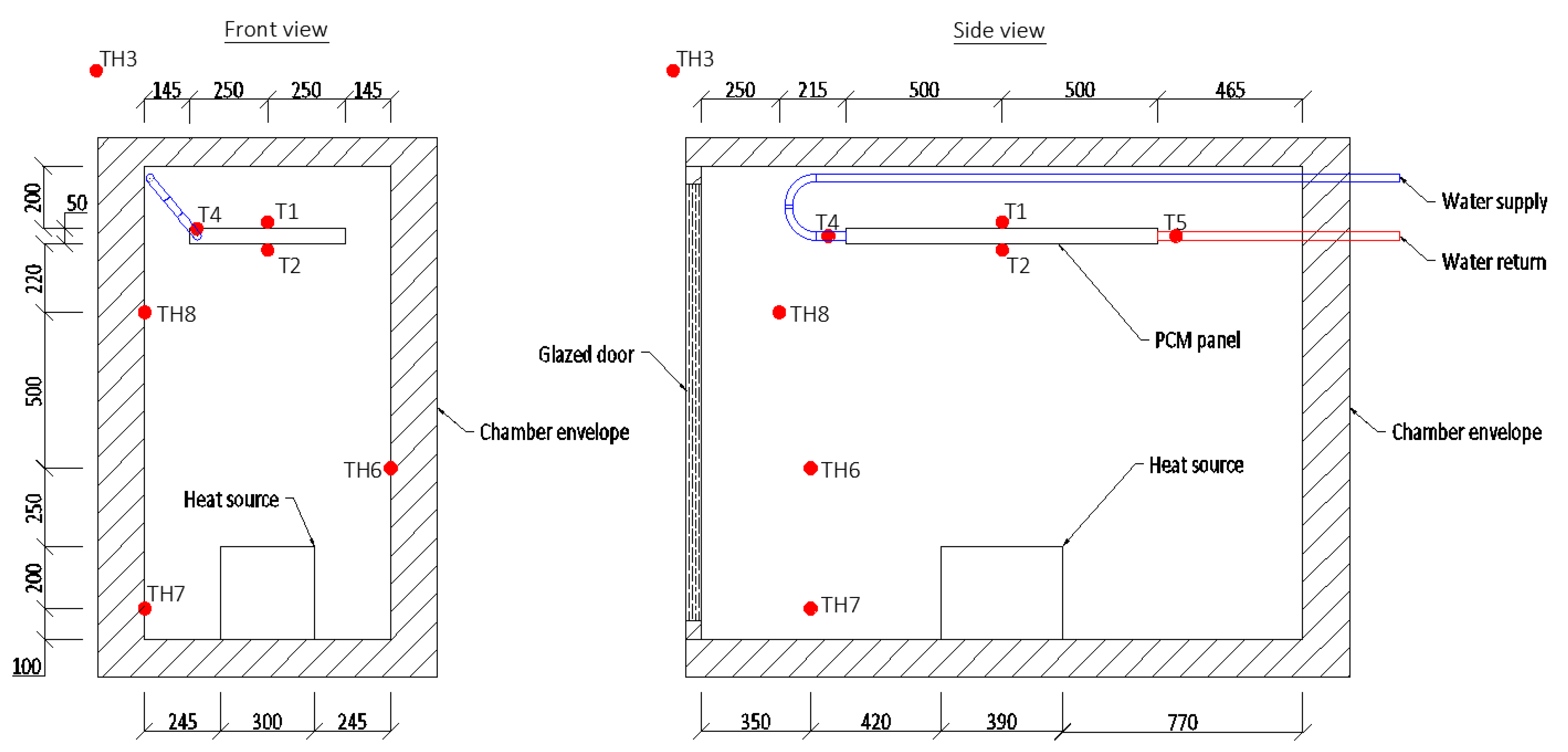
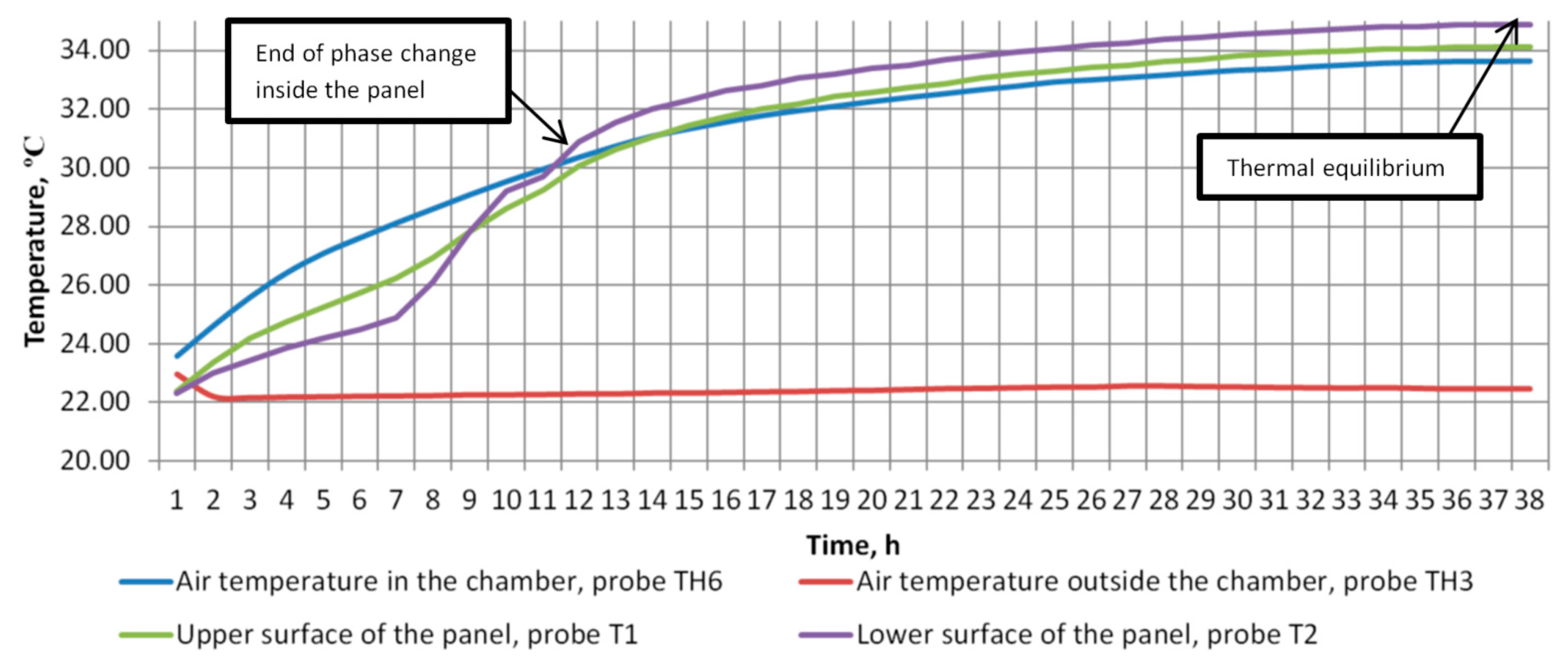



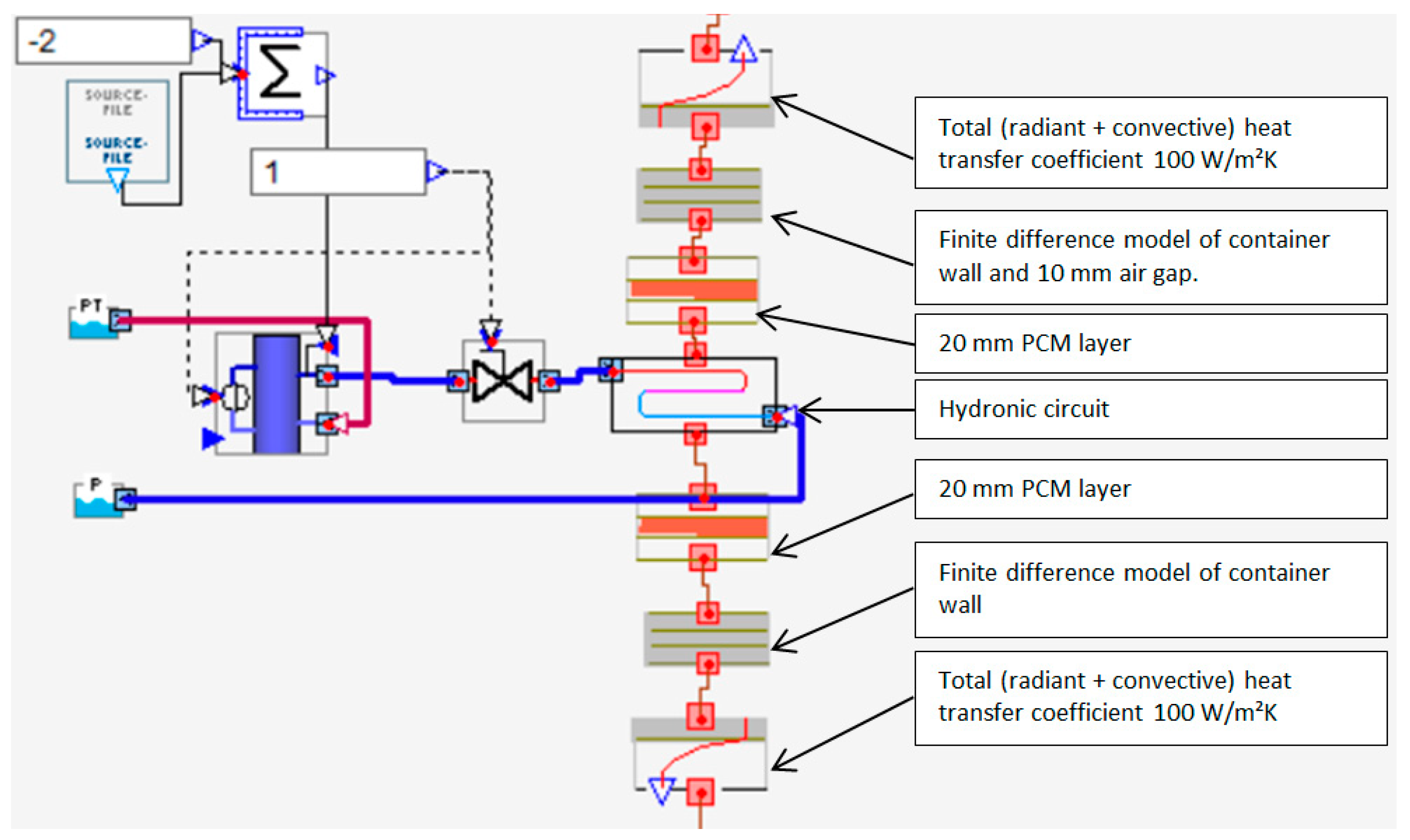
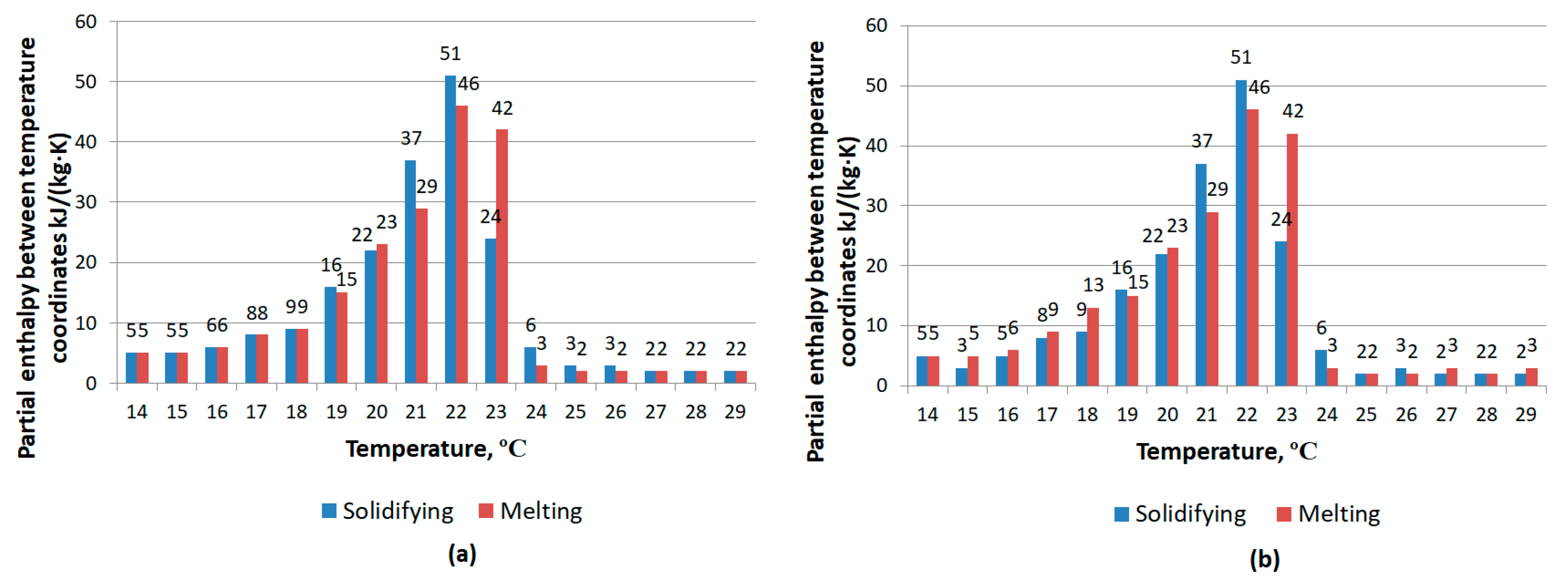




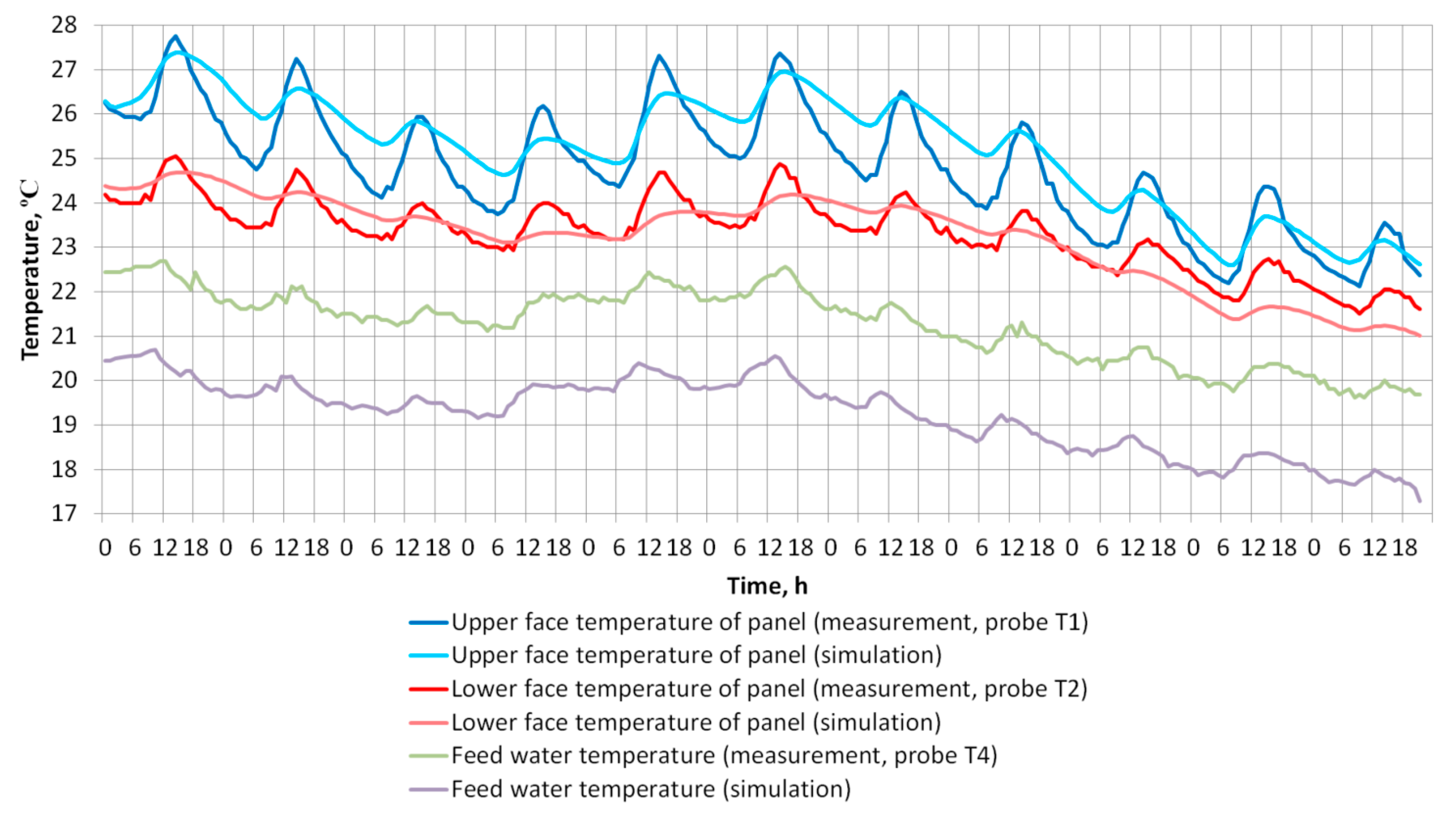
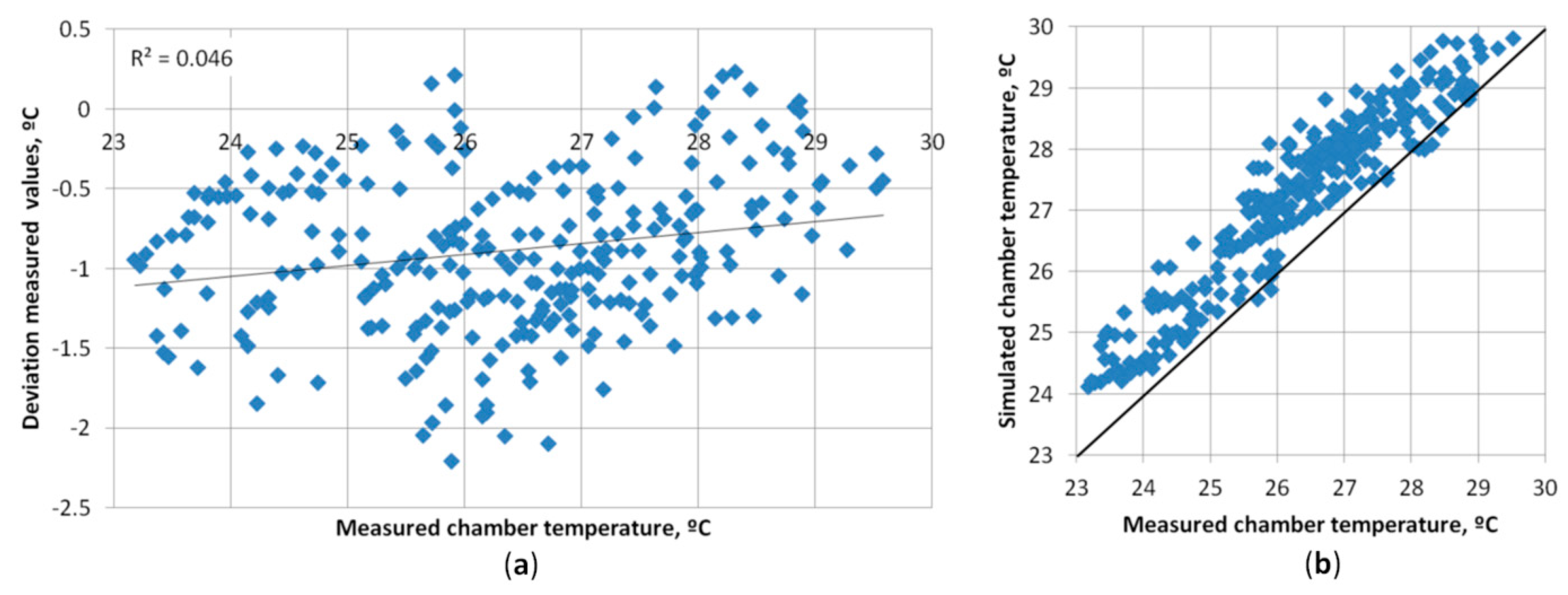

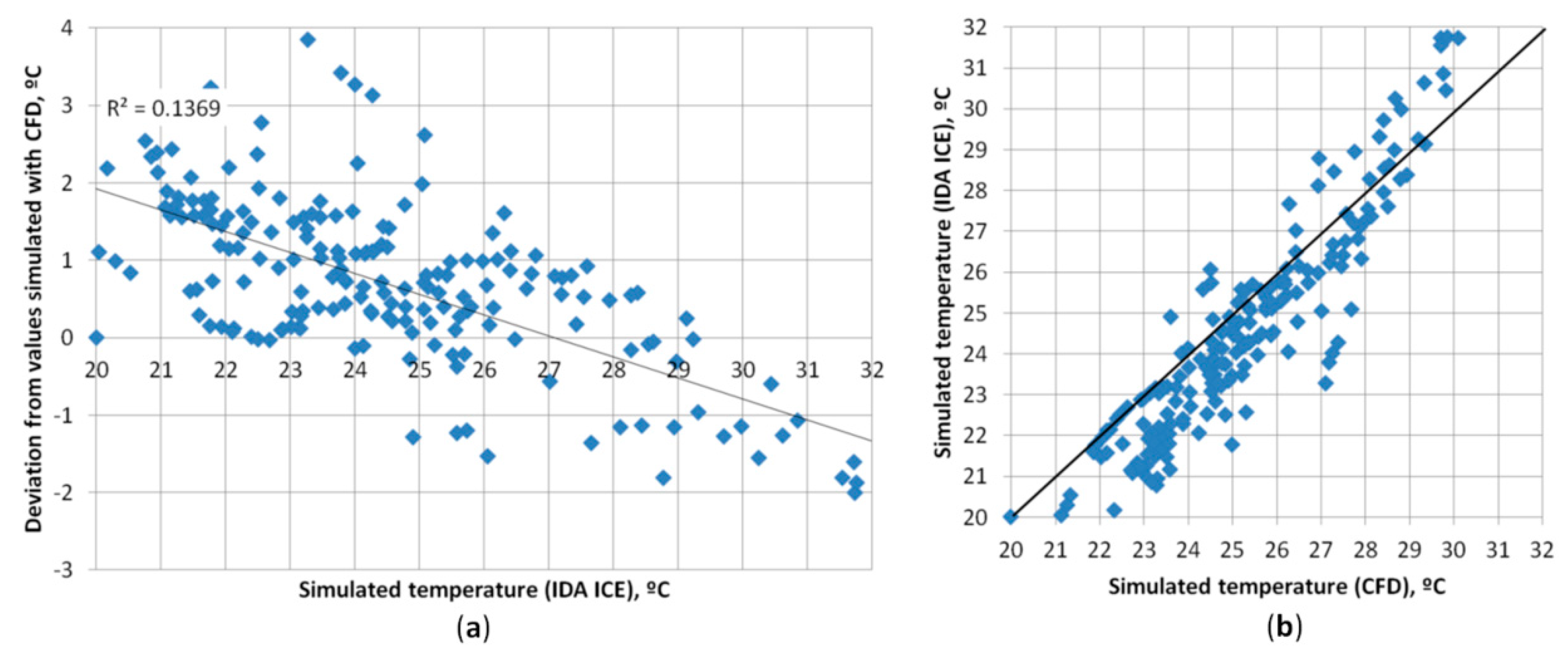
| City | Outdoor Air Wet Bulb Temperature Corresponding 1% (87.6 H) Annual Exceedance 1 |
|---|---|
| Riga (WMO 264220) 2 | 19.6 °C |
| Tallinn (WMO 260380) 2 | 19.0 °C |
| Helsinki (WMO 029750) 2 | 19.4 °C |
| Stockholm (WMO 024840) 2 | 18.8 °C |
| Structure | Material | Density, kg/m³ | Specific Heat, J/(kg·°C) | Thermal Conductivity, W/(m·°C) |
|---|---|---|---|---|
| Inner wall and slabs | Concrete | 2322 | 850 | 1.7 |
| External wall | Outer layer (30 mm) | 452.2 | 1650 | 0.112 |
| Middle layer (290 mm) | 210.1 | 1250 | 0.062 | |
| Inner layer (30 mm) | 332.5 | 1450 | 0.077 | |
| Window | U-value = 1.9 W/m²K (g-value = 0.6) | |||
| Finishing layer of the ceiling | Gypsum | 800 | 950 | 0.15 |
Publisher’s Note: MDPI stays neutral with regard to jurisdictional claims in published maps and institutional affiliations. |
© 2020 by the authors. Licensee MDPI, Basel, Switzerland. This article is an open access article distributed under the terms and conditions of the Creative Commons Attribution (CC BY) license (http://creativecommons.org/licenses/by/4.0/).
Share and Cite
Millers, R.; Korjakins, A.; Lešinskis, A.; Borodinecs, A. Cooling Panel with Integrated PCM Layer: A Verified Simulation Study. Energies 2020, 13, 5715. https://doi.org/10.3390/en13215715
Millers R, Korjakins A, Lešinskis A, Borodinecs A. Cooling Panel with Integrated PCM Layer: A Verified Simulation Study. Energies. 2020; 13(21):5715. https://doi.org/10.3390/en13215715
Chicago/Turabian StyleMillers, Renars, Aleksandrs Korjakins, Arturs Lešinskis, and Anatolijs Borodinecs. 2020. "Cooling Panel with Integrated PCM Layer: A Verified Simulation Study" Energies 13, no. 21: 5715. https://doi.org/10.3390/en13215715
APA StyleMillers, R., Korjakins, A., Lešinskis, A., & Borodinecs, A. (2020). Cooling Panel with Integrated PCM Layer: A Verified Simulation Study. Energies, 13(21), 5715. https://doi.org/10.3390/en13215715








